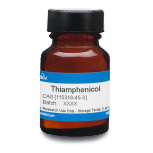TOKU-E
Research Antibiotics, Thiamphenicol, 5 grams
- Part Number:
- TOK-T005-5g
- Lead Time:
- 2-3 days
- Shipping:
- FREE SHIPPING on most orders over $50*
- Quantity:
- each
- Size:
- 5 grams
- Style:
- chemical
Description
Thiamphenicol, 5 gram. Thiamphenicol is a bacteriostatic antibiotic derived from chloramphenicol. Like chloramphenicol, thiamphenicol is insoluble in water but highly soluble in lipids.
- Category: Microbiology
- CAS Number: 15318-45-3
- Molecular Formula: C12H15Cl2NO5S
- Molecular Weight: 356.22 g/mol
- Mechanism of Action: Both thiamphenicol and chloramphenicol work by the same mechanism, however, thiamphenicol is about 3X as potent. After entering a bacterial cell, thiamphenicol binds to the 50S ribosomal subunit preventing peptide bond formation. Resistance to thiamphenicol may be due to decreased cell permeability or a mutation in the 50S ribosomal subunit.
- Storage Conditions: 2-8°C
- Tariff Code: 2941.40.0000
- Spectrum: Thiamphenicol is a broad spectrum antibiotic commonly used to target bacteria responsible for causing sexually transmitted diseases.
Microbiology Applications
Thiamphenicol is commonly used in clinical in vitro microbiological antimicrobial susceptibility tests (panels, discs, and MIC strips) against gram positive and gram negative microbial isolates. Medical microbiologists use AST results to recommend antibiotic treatment options for infected patients. Representative MIC values include:
- Neisseria gonorrhoeae 0.125 µg/mL – 4 µg/mL
Plant Biology Applications
In a study by Meynier et al. (1989), thiamphenicol was used for hygienic purposes in hybrid walnut propagation. In addition to other antibiotics used during the study, thiamphenicol was found to be effective against several gram negative pathogenic bacteria.
Specifications
- Form: powder
- Appearance: off-white powder
- Source: synthetic
- Melting Point: 164.3-166.3°C
- Absorbance: UV max (95% ethanol): 224, 266, 274 nm (ε 13,700, 800, 700).
References
Duck, P. D., and J. R. Dillon. "Effects of Thiamphenicol and Chloramphenicol in Inhibiting Neisseria Gonorrhoeae Isolates." Antimicrobial Agents and Chemotherapy 14.5 (1978): 788-90. www.ncbi.gov. 26 July 1978. Web. 21 Aug. 2012.
Mayer, Gene, Dr. "Antibiotics - Protein Synthesis, Nucleic Acid Synthesis, and Metabolism." University of South Carolina School of Medicine. Web. 21 Aug. 2012.
Meynier V. and Arnould M.F., 1989, Compared Effectiveness of Antibiotic Treatments and Shoot Tip Culture on Bacterial Decontamination of an in vitro Propagated Clone of Hybrid Walnut (Juglans nigra x J. regia). Biologia Plantarum (PRAHA) 31 (4): 269-275. 1989
Available Documents
Made by an ISO 9001:2015 certified antibiotic manufacturer focused on creating antibiotics through fermentation.
By removing contamination and streamlining gene selection, these research antibiotics help scientists make discoveries in cell/plant biology, microbiology, virology, stem cell therapy, and cancer research. Specializing in the pharmaceutical and biotech research sectors.
These products are specifically designed for research use and are not approved for human or animal consumption. Not FDA approved.
Note: These chemicals are for research & laboratory use only. Your order will not be processed if you do not ship to a registered laboratory or research facility.
Please note: This product is not returnable.

